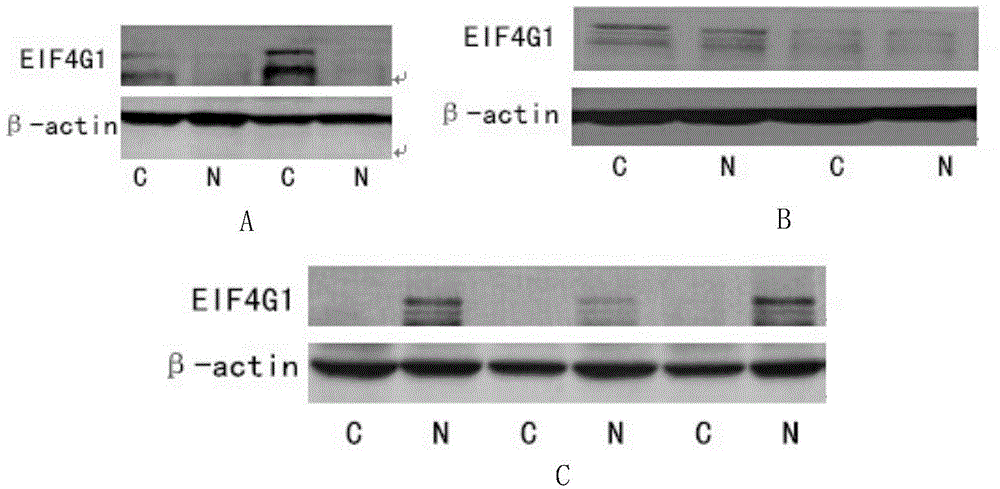Applications of EIF4G1 in diagnosis and treatment of squamous cell carcinomas
A 4G1, squamous cell carcinoma technology, applied in the field of tumor diagnosis and treatment, can solve the problems of drug resistance and unclear disease mechanism of NSCLC
- Summary
- Abstract
- Description
- Claims
- Application Information
AI Technical Summary
Problems solved by technology
Method used
Image
Examples
Embodiment 1
[0142] Example 1 Detection of EIF4G1 expression in NSCLC tumor tissue and paracancerous specimens
[0143] Selected 32 cases, all obtained from Shanghai Dongfang Hospital, including different stages of lung adenocarcinoma, squamous cell carcinoma, and large cell carcinoma. The obtained NSCLC cancer and adjacent tissues were detected by Western blot method to detect the expression of EIF4G1 in the tissues of 32 patients, and the relationship between the expression of EIF4G1 and the occurrence and development of NSCLC was analyzed.
[0144] The results showed that among the 32 patients, the expression of EIF4G1 in tumor specimens was higher than that in adjacent tissues in 16 cases (50%) ( figure 1 A), while 12 patients (37.5%) showed the opposite result ( figure 1 C), the expression of EIF4G1 in the paracancerous tissue was higher than that in the tumor tissue; there were 4 patients (12.5%) whose EIF4G1 expression was not significantly different between the tumor specimen and th...
Embodiment 2
[0146] The expression of EIF4G1 in the squamous cell carcinoma case of embodiment 2
[0147] Based on the results of Example 1, further analysis was carried out on the results of EIF4G1 in known squamous cell carcinoma of the lung, the results showed that ( figure 2 ), the expression level of EIF4G1 in all squamous cell carcinomas was higher than that in adjacent tissues, it can be seen that EIF4G1 may be a molecular marker that is generally increased in squamous cell carcinomas.
Embodiment 3
[0148] Example 3 Expansion verification of lung squamous cell carcinoma sample size
[0149] In order to expand the sample size for verification, another 20 cases of tumor tissue and paracancerous tissue known as squamous cell carcinoma (purchased from Xi'an Best Biotechnology Co., Ltd.) were purchased, and the expression of EIF4G1 in squamous cell carcinoma was further analyzed by immunohistochemistry. Express the situation.
[0150] From the results of immunohistochemistry ( image 3 ), in all squamous cell carcinomas, EIF4G1 was higher than that in paracancerous tissues and normal tissues.
[0151] Example 4 Sample Verification of Nasopharyngeal Carcinoma and Breast Cancer Squamous Cell Carcinoma
[0152] Take 20 cases of nasopharyngeal carcinoma and breast cancer (tumor tissue and paracancerous tissue), among which the pathological types of nasopharyngeal carcinoma include squamous cell carcinoma (7 cases) and non-keratinizing carcinoma (13 cases), and the pathological t...
PUM
 Login to View More
Login to View More Abstract
Description
Claims
Application Information
 Login to View More
Login to View More - R&D
- Intellectual Property
- Life Sciences
- Materials
- Tech Scout
- Unparalleled Data Quality
- Higher Quality Content
- 60% Fewer Hallucinations
Browse by: Latest US Patents, China's latest patents, Technical Efficacy Thesaurus, Application Domain, Technology Topic, Popular Technical Reports.
© 2025 PatSnap. All rights reserved.Legal|Privacy policy|Modern Slavery Act Transparency Statement|Sitemap|About US| Contact US: help@patsnap.com



